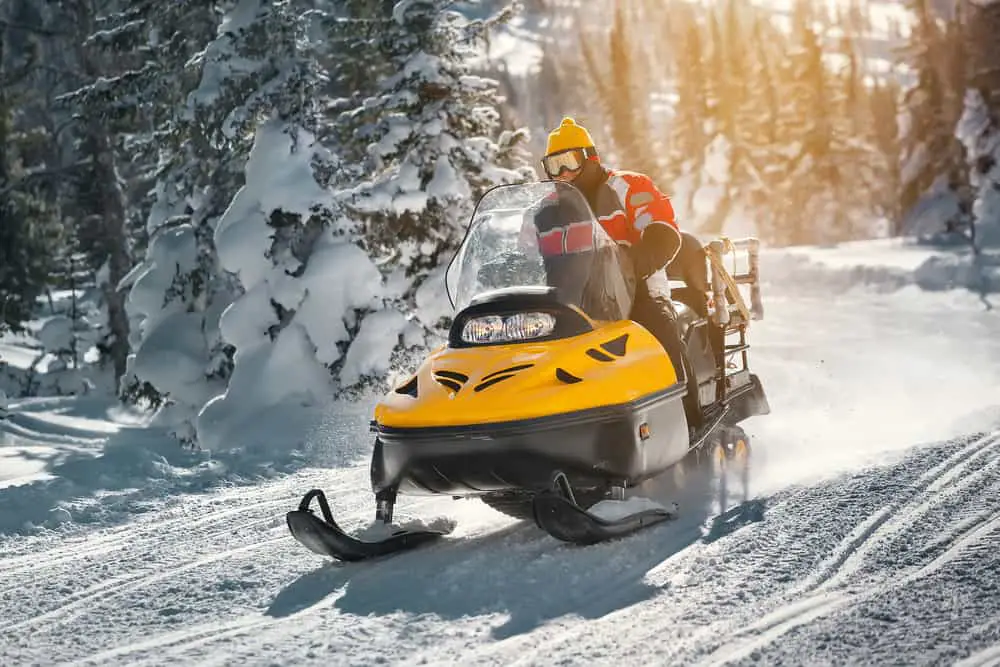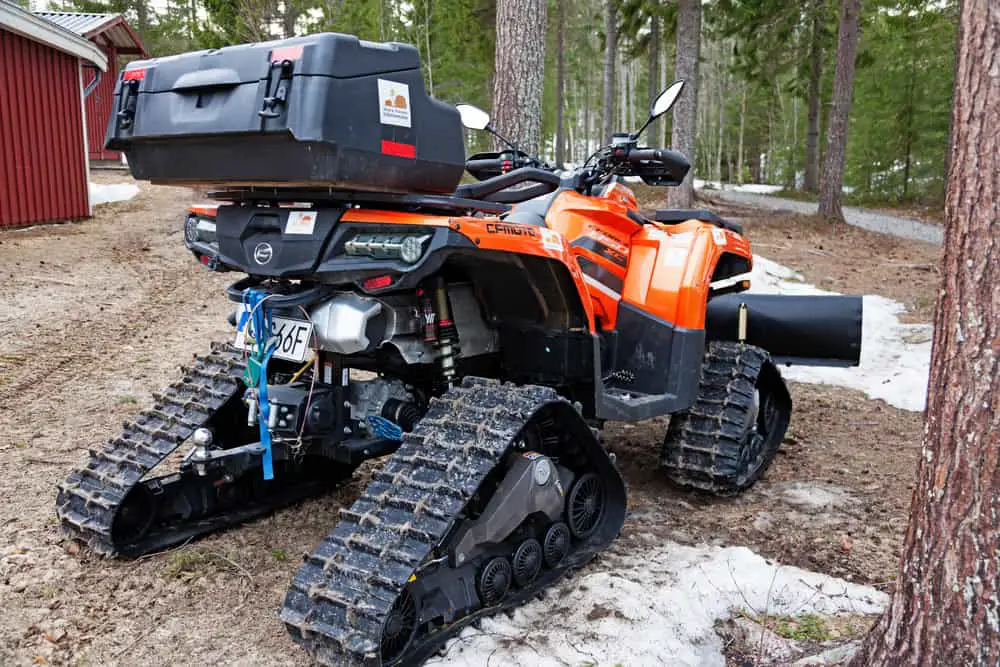
Driving off-road is fun. Away from gridlock, traffic lights, and speeding fines, the adrenalin comes thick and fast. But when I want to get my winter fun on, do I settle for a dedicated snow machine or an all-terrain vehicle hacked for the fluff?
Snowmobiles are lighter, faster, and more maneuverable on wet surfaces than ATVs with tracks. They’re also slightly less risky. ATVs can traverse a wider variety of terrain, making them more versatile. They are also more powerful, which better equips them to do work in the snow.
How this translates into a final answer is a matter of context and taste – the answer differing from person to adventurer.
How To Compare ATV Tracks And Snowmobiles
ATV Tracks and Snowmobiles share similarities and differences. This guide will consider a number of the factors that should be of interest to anyone considering an investment in either.
The factors we consider have to do with owning, operating, and enjoying the machines. In arriving at your own decision, you have to weigh these factors. Since that is personal and dependent on the context of different readers, we will not suggest a weighting scheme.
Be particularly cognizant of the terrain in which you intend to operate the machine of your choice. This is not likely to change much, as both machines are not very portable, whence the landscape of your locally accessible playground is likely to be the terrain of reference.
Likewise, have regard to the local weather prevailing at your probable recreation time. This determines changes in terrain (e.g., snow to grass) which similarly should affect how you weigh the different factors.
Finally, remember that a track-fitted ATV really is two vehicles in one. When the tracks come off and the wheels return, you have a quad bike. Snowmobiles do not morph into anything else. If toggling between wheels and tracks is a realistic option, factor that in your comparison.
The Design Of ATV Tracks
ATV tracks are all-terrain vehicles (“quad bikes”) with the wheels removed and replaced by wide rolling tracks. These tracks increase the weight distribution and traction, allowing the machine to navigate a broader set of terrain, including snow.
Quad bikes are designed with a high center of gravity and four broad wheels set far apart. The width and weight of the wheels make it hard to capsize, giving the machine stability over rough terrain.
The rubber tracks on ATVs are designed to maximize floatation, which increases mobility in deep snow. Coupled with that is an aggressive tread pattern, which provides optimal grip in all snow conditions.
The tracks are sized to match the output power of the bike. Putting a full-sized track kit on a low-power vehicle will impede its performance, though it will still work.
A strong track frame holds all the parts together. It is optimized to be strong enough to weather impacts and lightweight enough to maintain the cherished floatation on the snow. The frame angles upwards at the front, allowing the tracks to pass objects and better float on soft surfaces.
UTVs (utility terrain vehicles) are commercial ATVs designed for work rather than recreation and racing. They are larger than ATVs and outside the scope of this article.
The Design Of Snowmobiles
A snowmobile is, in effect, a motorized sled, which has led snowmobilers in the 1980s to describe themselves as “sledders.” The name has stuck. Thinking about the structure of a sled offers insight into the design of a snowmobile.
The machine is structured with a low-slung cabin supported on two skis. The skis are widely parted and angled inward. This design creates a machine with a low center of gravity, making it less likely to capsize. The sleds are bent upward, preventing the vehicle from plowing into the snow.
The rear of the snowmobile rests on a wide, rutted track. This gives traction and speed in diverse terrain. The track and its powering engine are located at roughly the same position and relative orientation as on a motorcycle. A drive belt transmits power from the engine to the track.
Aluminum shock absorbers are fitted to the front. They absorb energy on impact, making for a smoother ride. A snow expelling mechanism involves spiral grooved wheels which work to expel impacted snow that they pass.
Comparing ATV Tracks And Snowmobiles
We now consider how the design differences described above impact the variables in our comparison. Changes in technology have had an impact on these comparisons, with innovation in the design of ATV tracks narrowing the gap in its favor.
Versatility
As their name suggests, ATVs give the rider mobility on a variety of terrains. Snowmobiles are deceptively named, as they can be used on other ground – like ice and grass. We consider their performance on the types of turf that each machine is capable of navigating.
Winter Weather
The main arena is snow. The two relevant varieties are:
Fresh Snow
Both snowmobiles and ATV handle light, fresh snow. When the snow is very thin on the ground, or when it falls unevenly so that there are thin patches, the problem is created for snowmobiles.
Here they run the risk of running into the hard, uncovered ground, which may damage the snowmobile and cause it to grind down.
The ATV does not need tracks when the snow is thin on the ground, as the tires handle this terrain adequately. With tracks, the ATV performs well. Since the tracks roll, they are able to handle hard ground with little or no snow.
Deep Snow
Snowmobiles have superior floatation and come into their own, gliding over deep snow. ATV tracks are able to handle deep snow, even though their floatation is less than that of snowmobiles. The deeper the snow, the broader the tracks required.
ATV without tracks cannot handle deep snow.
Ice
Ice is unsafe to traverse and should be avoided. The biggest risk is variability in thickness, with ice less than 8in thickness less able to support the weight of a snowmobile. ATVs are heavier and so are more likely exposed to this risk.
The bulk and low floatation of ATVs also exposes them to more of the risk of losing the vehicle to sinking.
Both snowmobiles and ATVs can handle ice. Indeed, ice anglers often choose these vehicles for their expeditions. ATVs can be fitted with traction chains instead of tracks, which allows them to traverse snow.
Slush
Both snowmobiles and ATVs are slush-averse. Using either machine, you’ll want to avoid this terrain. It increases the risk of both machines getting stuck as the ice fragments clog the propulsion mechanisms.
In addition, recall that slush is an indication of thinning ice. All the warnings of thin ice in the previous section refer.
If in spite of everything, slush happens, snowmobiles are less likely to get stuck. They are easier to salvage once stuck as they’re lighter and can be dislodged by hand. A stuck ATV would need another ATV to haul it out.

Summer Weather
Outside of snow, the following terrain is traversable:
Grass
Grass dragging is a popular off-winter snowmobile activity. Here the machines show their ability to navigate dry terrain. The grass is a trivial terrain for ATVs, and the tracks are not required.
The major difference is that due to their power, ATVs are able to negotiate grassy mounds better than snowmobiles. For this, tracks are not required as the wheels will do.
Water
ATVs sink in water. They are bulky and sluggish. Tracks don’t change this. The other vehicles have it differently, though.
Snowmobiles would sink on the surf, but with some modification, they compete with jet skis. Sealing the engine and making the machine lighter (removing the seat and replacing the 10-gallon tank with one-tenth the capacity) is the first step. Next is to keep the front hoisted out the water. This is done by adjusting the rear shocks.
The snow flap is marshaled to act as a rudder. With modification, the snowmobile weighs under 400lb. Finally, add a minimum speed. By traveling at a minimum of 16mp, the snowmobile can skim across the water for miles. It is capable of acrobatic maneuvers.
Marsh
Mud is a terrain in which the duality of the ATV comes to the fore. ATV tracks work well in a variety of muddy conditions. Very wet mud deeper than about a foot and a half tests the traction of the tracks. In this case, fit mud tires, and you’re good to go.
The trick is to maintain your speed as best you can off the thinner mud. Entering the marsh at speed, the tracks will keep floatation due to their increased surface area – provided you can ramp up the speed to support the cruise.
Where speed is harder to come by, and the marsh is rocky, fitting the wheels back on makes the terrain easier to manage.
For snowmobiles, mud dragging is a popular summertime activity. This is limited in a few ways:
Sand
With modification, snowmobiles are capable of riding in sand. The main adaptations needed are to control the heat. This is done by adding an air filter, a radiator, and other engine-cooling components. The tracks need to keep running, and ideally, idler wheels should be added to maintain the traction.
ATVs, on the other hand, are designed for sand. Even with tracks, their engines are not at risk of overheating, and with the wheels on, they are capable of improved dune climbing and maneuverability.
Trail
Neither snowmobiles nor track-fitted ATVs are built for snow-free trails. But switching to wheels, the ATVs handle this terrain with ease.
Road
Technically, ATVs with wheels can be driven on the road, but apart from violating traffic ordnances, this is not a pleasant experience due to the knobbly wheels, low speed, and unwieldy structure.
Performance
We consider the performance on the snow of the two machines. This is the application where a head-to-head comparison is likelier. We’ll consider speed, power, weight, and maneuverability, as these are the factors that determine how steady the ride is.
Power
ATVs are the more powered of the two. This is the tradeoff with mobility, which works in favor of snowmobiles. The power differential has these practical implications:
At the extremes, though, an entry-level ATV with tracks mismatched to its engine may yield less horsepower than a high-end snowmobile modified for power.
Speed
Snowmobiles are lighter and faster than ATVs. ATV tracks have to be calibrated to match the power of their engines. It is recommended not to exceed 40mph on a track-fitted ATV. Snowmobiles, on the other hand, reach speeds between 120mph and 150mph.
This difference in speed is critical in race conditions, as an ATV cannot come close to coping. In mixed terrain, the snowmobile is unable to maintain a constant velocity, and consequently, the differential matters less.
Weight
The average snowmobile has a mass of 490lb. The mass of a recreational ATV fully-sized is around 700lbs, with the tracks alone weight 60-110lbs. ATVs tend to have greater weight variability than snowmobiles.
This mass has practical applications:
Maneuverability
The combination of lightness and speed gives snowmobiles a maneuverability edge. This is compounded by the low design of the snowmobile, which makes it harder to overturn, and therefore safer to ride and turn at a higher speed.
What ATVs have in compensation is climbing power, alluded to above. In more varied terrain, such as trails, this climbing power is critical as it reduces the chance of the vehicle getting stuck.
Where maneuverability is concerned, ATVs are more useful and snowmobiles more fun.
Ease Of Use
Both snowmobiles and ATVs are relatively easy to use. For snowmobiles, there is a period of acclimation – lasting four to five rides – in which the rider gets accustomed to the proprioception of a low-profile machine. The actual operation of the snowmobile is easy.
ATVs have a shorter period of acclimation, as they somewhat resemble bike riding, which most beginners have a prior acquaintance with. The risk, though, is that new rides underestimate the risk of capsizing.
An added complexity for ATVs is acquiring and fitting a track kit that matches your bike. The acquisition side can be ameliorated with expert help. And while you can get the tracks professionally fitted, this is something you want to learn to do yourself in order to switch smoothly between tracks and wheels.
Safety
In the case of snowmobiles, the safety concerns revolve largely around getting stuck in unsuitable terrain. This is managed by limiting your adventures to the unknown.
For ATV, the risk of capsizing and increased exposure to thin ice have safety implications.
In the case of both vehicles, be sure to kit up and wear the appropriate gear. Getting stuck or losing your vehicle is a risk that is managed by venturing out in company – with people who have the skill and equipment to rescue you.
Conclusion
The argument can be made either way – perhaps this is the reason who manufacturers have kept turning out new models of snowmobiles as well as new configurations of ATV tracks.
Be guided by your circumstance, risk tolerance, and the kind of adventure that gets you going.
References
- https://www.explainthatstuff.com/how-snowmobiles-work.html#definition
- https://www.bartleby.com/essay/How-Atvs-Work-PK4P2H3DRTS
- https://adventure.howstuffworks.com/outdoor-activities/off-roading/off-road-atvs.htm
- https://www.acurite.com/blog/types-of-snow.html
- https://www.youtube.com/watch?v=ckbn5JyyP4U
- https://www.mainepublic.org/environment-and-outdoors/2021-01-22/it-dont-look-too-good-to-me-lack-of-snow-puts-maine-snowmobile-season-on-the-skids
- https://www.pdac.ca/docs/default-source/priorities/responsible-exploration/e3-plus—common/e3-plus—toolkits—health-and-safety/snowmobiles.pdf?sfvrsn=a48353f3_4
- https://dnr.wisconsin.gov/Education/OutdoorSkills/IceSafety
- https://www.deeranddeerhunting.com/content/articles/10-tips-ice-pros-use-to-beat-deep-slush-conditions
- https://www.theglobeandmail.com/globe-drive/culture/technology/ride-on-snow-or-water-with-a-redesigned-snowmobile-that-floats/article29010831/
- https://www.newyorkupstate.com/outdoors/2017/06/we_ask_a_cornell_physicist_how_fast_should_snowmobiles_go_to_cross_open_water.html


